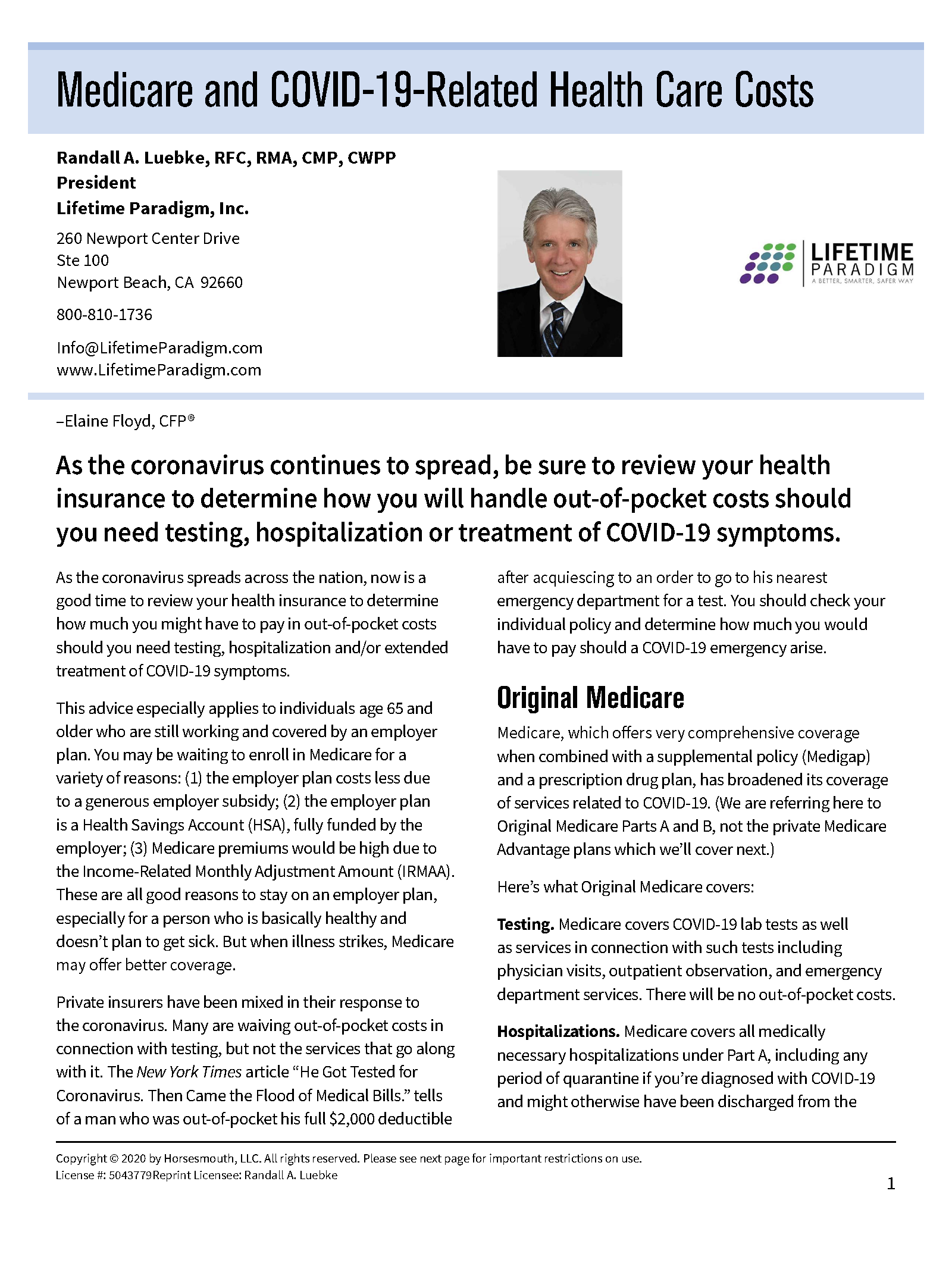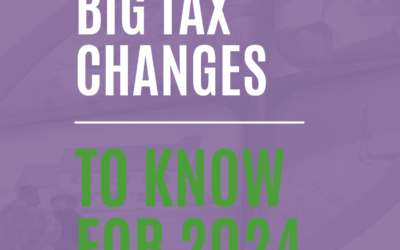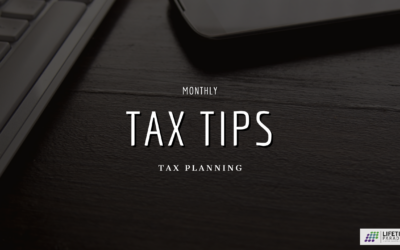Asset Protection
Medicare and Covid-19 Related Health Care Costs
As the coronavirus continues to spread, be sure to review your health insurance to determine how you will handle out-of-pocket costs should you need testing, hospitalization, or treatment of COVID-19 symptoms.
As the coronavirus spreads across the nation, now is a good time to review your health insurance to determine how much you might have to pay in out-of-pocket costs should you need testing, hospitalization and/or extended treatment of COVID-19 symptoms.
This advice especially applies to individuals age 65 and older who are still working and covered by an employer plan. You may be waiting to enroll in Medicare for a variety of reasons: (1) the employer plan costs less due to a generous employer subsidy; (2) the employer plan is a Health Savings Account (HSA), fully funded by the employer; (3) Medicare premiums would be high due to the Income-Related Monthly Adjustment Amount (IRMAA). These are all good reasons to stay on an employer plan, especially for a person who is basically healthy and doesn’t plan to get sick. But when illness strikes, Medicare may offer better coverage.
Private insurers have been mixed in their response to the coronavirus. Many are waiving out-of-pocket costs in connection with testing, but not the services that go along with it. The New York Times article “He Got Tested for Coronavirus. Then Came the Flood of Medical Bills.” tells of a man who was out-of-pocket his full $2,000 deductible after acquiescing to an order to go to his nearest emergency department for a test. You should check your individual policy and determine how much you would have to pay should a COVID-19 emergency arise.
Original Medicare
Medicare, which offers very comprehensive coverage when combined with a supplemental policy (Medigap) and a prescription drug plan, has broadened its coverage of services related to COVID-19. (We are referring here to Original Medicare Parts A and B, not the private Medicare Advantage plans which we’ll cover next.)
Here’s what Original Medicare covers:
Testing. Medicare covers COVID-19 lab tests as well as services in connection with such tests including physician visits, outpatient observation, and emergency department services. There will be no out-of-pocket costs.
Hospitalizations. Medicare covers all medically necessary hospitalizations under Part A, including any period of quarantine if you’re diagnosed with COVID-19 and might otherwise have been discharged from the hospital after an inpatient stay. Medicare covers 60 days of hospitalization after the Part A deductible of $1,408 has been paid. For days 61-90, there is a coinsurance cost of $352 per day. But if you have supplemental insurance you pay nothing: all Medigap policies cover the Part A deductible and hospital coinsurance costs for 365 days after Medicare benefits are used up.
Skilled nursing. Medicare generally covers up to 100 days of skilled nursing following hospitalization. During this crisis the hospitalization requirement is waived if patients need to be admitted to a skilled nursing facility to make room at hospitals. After the first 20 days in a skilled nursing facility, there is a daily coinsurance amount of $176; most Medigap policies cover that cost for days 21 through 100. There is no coverage after the 100th day.
Vaccines. At this time, there’s no vaccine for COVID-19. However, if one becomes available, it will be covered by all Medicare Part D prescription drug plans.
Telehealth. Medicare has expanded its coverage of telehealth services, which allow for doctor visits via computer or smart phone. Telehealth will be covered under Part B for all traditional Medicare enrollees during the virus crisis, and services are not limited to COVID-19 care. The definition of telehealth has also been expanded. Previously, patients were required to connect from a health facility that had approved video conferencing technology; now, patients will be able to connect from home via video on a smartphone or other digital device.
Outpatient services. Other medical services are covered as usual under Part B. There is an annual deductible of $198 and a coinsurance amount of 20%. Most Medigap policies cover the full 20%. Plans F and C (no longer sold to people turning 65 after 2019) also cover the deductible.
Medicare Advantage and Part D drug plans
Medicare Advantage plans are required to cover all care under Parts A and B, but might impose different costs or restrictions. A Kaiser Family Foundation study found that for hospital stays of five days or more, Medicare Advantage enrollees paid more than the $1,408 Part A deductible under Original Medicare (which is fully covered for clients with Medigap). For stays of 10+ days, Medicare Advantage enrollees paid over $2,000 out of pocket.
The government declared a national public health emergency on January 31, in part to impose special requirements on Medicare Advantage and Part D plans. These requirements were legislated by the CARES Act, which was signed into law on March 27. Plans must:
- Allow beneficiaries to receive health care services at out-of-network doctors’ offices, hospitals, and other facilities without additional charges
- Waive gatekeeper referral requirements
- Suspend rules that require beneficiaries to tell the plan before obtaining certain kinds of care or prescription drugs, if failing to contact the plan ahead of time would limit access to care
- Cover the maximum supply of drug refills if requested.
Part D plan sponsors are also required to ensure that their enrollees have adequate access to covered Part D drugs at out-of-network pharmacies when enrollees cannot reasonably be expected to use in-network pharmacies. Part D plans may also relax restrictions they may have regarding methods of delivery, such as mail or home delivery, to ensure access to needed medications for enrollees who may be unable to get to a retail pharmacy.
The Centers for Medicare and Medicaid (CMS) has issued guidance to help Medicare Advantage and Part D plans respond to COVID-19, but plans will differ in how they apply these guidelines. You will need to check with your individual plans for details.
What if you are 65+ and employed?
You may take this opportunity to switch from employer coverage to Medicare. Perhaps you lost your job— and health insurance—due to the coronavirus crisis. Economists at the Fed’s St. Louis district project total employment reductions of 47 million, which would translate to a 32.1% unemployment rate. Many of these job losses have already occurred, more are yet to come. Newly unemployed individuals age 65 and older can at least be thankful that the transition from employer insurance to Medicare is easy and will ensure comprehensive, cost-effective coverage at a time when there is a greater likelihood of serious illness.
Or perhaps your employer insurance is not as comprehensive as Medicare, particularly if it has high out-of-pocket maximums. Someone with such a plan who contracts COVID-19 could be on the hook for thousands of dollars in medical expenses should hospitalization and intensive care be needed.
Transitioning to Medicare
Fortunately, the transition to Medicare is easy. If you are 65 or older and still working or newly terminated, you are still in your special enrollment period, which allows you to enroll in Medicare at any time (up to eight months after the employer insurance ends). To avoid a late-enrollment penalty, you would simply have the employer complete Form L564 attesting that you have been continuously covered by employer insurance.
Enrollment is done through the Social Security Administration (SSA), and is quick and easy. The harder part is choosing supplemental insurance. Those who get a Medigap policy at the same time they enroll in Part B will not be subjected to underwriting and will be able to get a policy no matter how sick they are. Use Medicare’s plan finder to search for Medigap policies and drug plans, or get help from a licensed agent.
If your income is more than $87,000 (single) or $174,000 (joint) you may be charged the Income-Related Monthly Adjustment Amount, or IRMAA. SSA will look at your 2018 tax returns to determine 2020 premiums. If income going forward will be lower due to a job loss or reduction of hours, you can appeal the IRMAA by filing Form SSA-44 within 60 days of receiving your premium notice.
Unlike employer plans, which are primarily designed for younger, healthier people for whom illness is rare, Medicare was designed for older people who tend to encounter more health problems as they age. When paired with supplemental insurance (Medigap) and a prescription drug plan, Medicare offers very comprehensive coverage. The biggest expense is the monthly premiums. Premiums for Part B, Medigap, and a drug plan should run around $300 to $400 a month (more if you are subject to the IRMAA). Once premiums are paid, there should be little or no out-of-pocket expenses for treatments related to COVID-19.
Going back to work
You might enroll in Medicare during a period of unemployment then go back to work and once again have access to employer health insurance. Should you take it? Or should you stick with your Medicare plan?
To help answer this, start with an analysis of the two plans, comparing benefits and out-of-pocket costs, including premiums, deductibles, and copayments. Employers cannot force employees to take the employer insurance. Employees over 65 have every right to opt out of the employer plan in favor of Medicare.
Still, there are two reasons why you might want to disenroll from Medicare and go onto the employer plan after going back to work: (1) Now that you are working, Medicare might cost significantly more due to the IRMAA; or (2) the plan is an HSA funded by employer contributions and you do not expect to need those contributions to meet the deductible (i.e., you don’t plan to get sick and would use the HSA as a tax-favored savings plan).
While it is possible to disenroll from Medicare in order to go onto an employer plan, there are two caveats.
(1) An individual who re-enrolls in Medicare upon retirement would not get another Medigap guaranteed- issue period. This means you may not qualify for a Medigap policy depending on health status and state of residence (New York, Connecticut, Maine, and Massachusetts require Medigap insurers to take everyone; the rest do not).
(2) In order to make HSA contributions, you would have to disenroll from both Part A and Part B and make sure no contributions are made for any month you are enrolled in any part of Medicare. SSA usually backdates the Part A enrollment by six months, so contributions for that period would have to be taken out. And remember that anyone receiving Social Security must enroll in Part A. Once you start receiving Social Security benefits, at age 70 if not before, there can be no further HSA contributions. A high-deductible plan without the employer’s HSA contributions would be far inferior to Medicare. You may want to ask your employer for a different, non-HSA type of plan. Then you’ll need to compare that plan to Medicare to see which plan offers the most benefits at the lowest cost.
Don’t let worries about health insurance add to your burden during these trying times. Seek out a financial advisor who can walk you through your options, especially when it comes to Medicare.
Elaine Floyd, CFP®, is Director of Retirement and Life Planning for Horsesmouth, LLC, where she focuses on helping people understand the practical and technical aspects of retirement income planning.
It’s a good life!
SERVICES WE OFFER RELATED TO THIS TOPIC
The information contained in this post is for general use and educational purposes only. However, we do offer specific services to our clients to help them implement the strategies mentioned above. For specific information and to determine if these services may be a good fit for you, please select any of the services listed below.
You May Also Like…
Your Co-Owned Business Probably Needs a Buy-Sell Agreement
Tax PlanningBradford Tax InstituteSay you’re a co-owner of an existing business. Or you might be buying an existing...
Big Tax Changes to Know for 2024
Financial Guides2024 has brought some big tax changes with it. It’s essential to stay informed about these...
The Smart Tax Planning Newsletter March 2024
Tax PlanningIn This Issue: IRAs for Young Adults Get Up to $32,220 in Sick and Family Leave Tax Credits New Crypto Tax...









